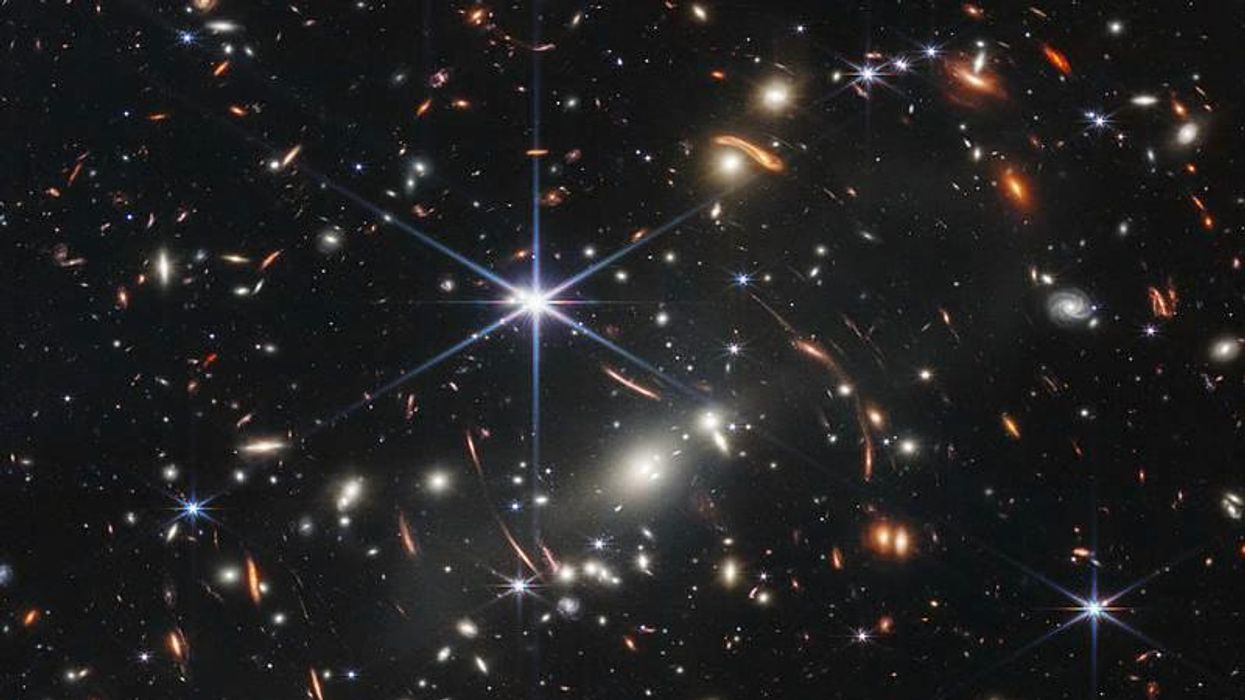Ariana Baio
Jul 12, 2022
Watch: NASA reveals Webb Telescope's 'deepest ever' infrared images of our universe
Video
Following several days of tears, NASA unveiled four high anticipated deep space photos from the James Webb Space Telescope and the images are spectacular.
For the first time in history, humans are able to see detailed photos of the wonders of the universe including the Carina Nebula, Southern Ring Nebula, Stephan's Quintet, and the most detailed spectrum of an exoplanet.
The first photo released is Webb's study of the hot gas giant WASP-96b located roughly 1,150 light years from Earth. The study produced a spectrum with wavelength-like dots.
"The labeled peaks in the spectrum indicate the presence of water vapor," the Webb Telescope press release says.
\u201cRelease #2: The first spectrum of an exoplanet atmosphere in the IR from #JWST, named WASP-96b. There's water, clouds, and hazes in the atmosphere! #UnfoldTheUniverse \n\n#UnfoldTheUniverse\u201d— Dr. Tanya Harrison (@Dr. Tanya Harrison) 1657637252
Sign up for our free Indy100 weekly newsletter
The second photo has captured a cloud of of gas surrounding a dying star from the Southern Ring Nebula.
Using Near-Infrared Camera (NIRCam), astronomers are able to highlight extremely detailed areas of the dying star.
"This is not only a crisp image of a planetary nebula – it also shows us objects in the vast distances of space behind it," NASA wrote. "The transparent red sections of the planetary nebula – and all the areas outside it – are filled with distant galaxies."
\u201cThe Southern Ring Nebula began when a star shuddered and died, launching its own atmosphere into space like an expanding soap bubble. The only part of the star left behind was a scalding-hot core known as a white dwarf, in the center of the image. https://t.co/6Efyka1EZh\u201d— The New York Times (@The New York Times) 1657636407
The third photo shows details of Stephen's Quintet, a visual grouping of five galaxies. Using multiple filters, image processing specialists at the Space Telescope Science Institute in Baltimore were able to differentiate the galaxies using green, red, and blue.
Stephen's Quintet contains a supermassive black hole 24 million times the mass of the Sun.
\u201cStephens Quintet\n\n5 galaxies \n\nLeft: JamesWebb\nRight: Hubble\u201d— Bruno\uea00 (@Bruno\uea00) 1657638736
The final photo is of the "Comic Cliffs" a region on the edge of a young, star-forming region NGC 3324 in the Carina Nebula. The name "Cosmic Cliffs" comes from its mystical mountain appearance.
Never before seen young stars are now visible thanks to the power of Webb.
\u201c\ud83c\udf1f A star is born!\n \nBehind the curtain of dust and gas in these \u201cCosmic Cliffs\u201d are previously hidden baby stars, now uncovered by Webb. We know \u2014 this is a show-stopper. Just take a second to admire the Carina Nebula in all its glory: https://t.co/tlougFWg8B #UnfoldTheUniverse\u201d— NASA Webb Telescope (@NASA Webb Telescope) 1657639238
The Webb telescope is the most powerful telescope ever built with over 30 years of research and construction dedicated to creating it.
First launched in 2021, the telescope is currently orbiting the Earth in L2 taking photos of the universe beyond what humans could explore. And the four photos released on Tuesday are just the beginning.
Able to take photos of galaxies and stars billions of lightyears away, Webb is able to capture the cosmos created after the big bang. With this technology, astronomers are hopeful Webb can assist humans in making new discoveries.
Have your say in our news democracy. Click the upvote icon at the top of the page to help raise this article through the indy100 rankings.
Top 100
The Conversation (0)














